 And we continue our series of articles dedicated to stage costumes of the most popular and loved by the audience films and serials. This time, we took the series “Shogun World” and will analyze the Japanese-style clothing. This show often impresses us with its pretty costumes, rather skillfully made and worn but not always accurate to the historical period (Japanese Edo period). As always, we’ll also add some photos of authentic articles of clothing – Japanese and Chinese in this case – to help you understand what is what.
And we continue our series of articles dedicated to stage costumes of the most popular and loved by the audience films and serials. This time, we took the series “Shogun World” and will analyze the Japanese-style clothing. This show often impresses us with its pretty costumes, rather skillfully made and worn but not always accurate to the historical period (Japanese Edo period). As always, we’ll also add some photos of authentic articles of clothing – Japanese and Chinese in this case – to help you understand what is what.
This material is based on the video from YouTube channel “Costume CO”.
In this article, we will look at the stage costumes of the series “Shogun World”, featured in the Season 2 Episode “Akane no Mai”.
“Shogun World” is Delos Destinations’ sister park to West World, the second of three parks that Delos offers. According to Delos Destinations, Shogun World is an artfully curated vacation destination inspired by Edo feudal Japan, where you can experience the full complexity of nature: beauty and danger, good and evil, in a place nestled from the passage of time.
The Edo period in the history of Japan took place between 1603 and 1868 when Japanese society was under the rule of the Shogunate and the country's 300 regional daimyō (or feudal lords). Edo was the capital city of Japan and present-day Tokyo.

Shogun World, according to Delos, offers an immersion experience, stating that the spirit of feudal Japan has been infused into every detail, meticulously designed to give you the experience of a lifetime.
Showrunner Lisa Joy tells Entertainment Weekly, “We looked to all our [department heads] to make sure we had the full thrill of exploring Shogun World… researching hair and production design and costume”.
Jonathan Nolan, by the way, says, “We felt free to have a composite with Shogun World and pick and choose. This is basically the Edo period, but with artifacts from across 300 years”.
One of the greatest surprises of the Shogun World episode is that Maeve is actually the Sweetwater counterpart to Akane, a geisha who runs the Japanese teahouse in Hirafuku.
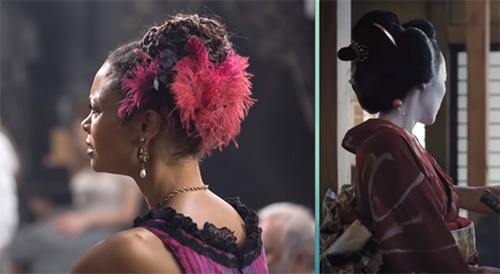
Likewise, Hanaryo is a copy of Armistice.
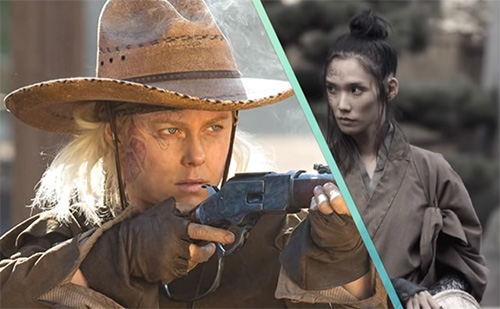
And Clementine Pennyfeather is the Sweetwater equivalent to Sakura.

The name Sakura translates as “cherry blossom”. Up until recently, the name was rarely given to a girl because cherry blossoms fall quickly from the tree and it was felt to be a bad omen that the child would die young.
As you can see here, Akane is dressed in a similar purple-red color to Maeve, while Sakura is dressed in blue-green like Clementine.
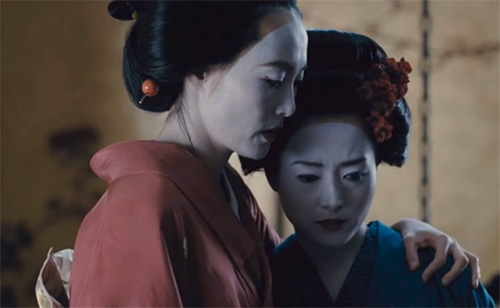
Costume designer Sharen Davis, known for her work in “The Magnificent Seven” reboot, has stated that while the color is not traditionally a kimono color, it does line up with Clementine’s color palette.
In this image, you can see that Sakura is dressed in a blue-green ombre silk kimono. “Ombre” is a French word meaning “to shade” and is used to describe a dip-dye effect given to fabric, in which the shades of color graduate from light to dark.
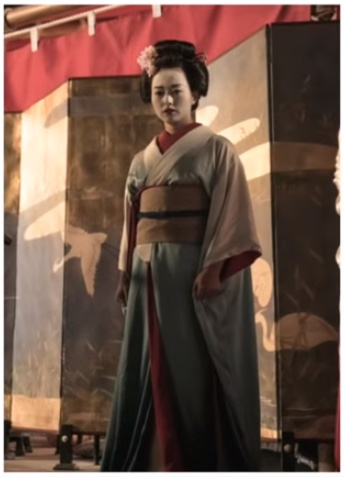
This type of formal kimono with long hanging sleeves is called a “furisode”. It was the primary formal wear of an unmarried woman during the Edo period.
Here's an example of a woman dressed in a furisode depicted in a Japanese woodblock print called “Plucking a branch from a neighbor's plum tree” from 1768.

This embroidered silk furisode is from the late Edo period and it's from The Art Institute of Chicago.

In the Edo period, the garments grew more decorative and colorful. Furisode were worn on special days or formal occasions.
Here's an example of a resist-dyed and painted silk satin furisode from the front and back perspective that's from the early 20th century. And this is from a display in New York.
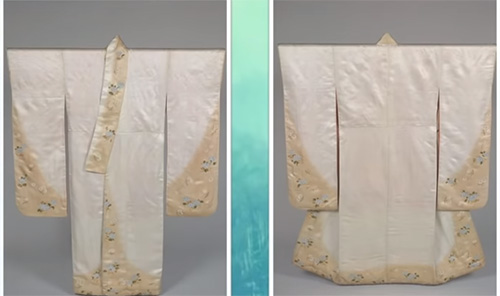
Sakura wears an under kimono in the same colors as Akane, showing their ties together. But it might also be symbolic of the blood of her death, as the spreading red silk looks like the blood gushing from her stab wound.

As we've mentioned before, Hanaryo is the equivalent to West World's Armistice. So a redactor pointed out that the writers used this as a way to quickly define the characters and flesh out their backstories without too much exposition and info dumping that will be required by Lee Sizemore. This also nods to the practice of Spaghetti Westerns lifting concepts and characters from Japanese samurai movies.
Hanaryo is likely based upon the Onna-bugeisha, which is a type of female warrior, belonging to Japanese nobility. These women engaged in battle, commonly alongside samurai men.

She dresses in the same color palette as Armistice, a sort of beige color. And Hanaryo wears a Japanese version of Armistice’s straw hat. Hers is a conical straw hat, sometimes called an “Asian rice hat”.

Hanaryo dresses like a male would in the Edo period. So, she's wearing a short kimono jacket tucked into hakama, which is essentially a split-skirt.
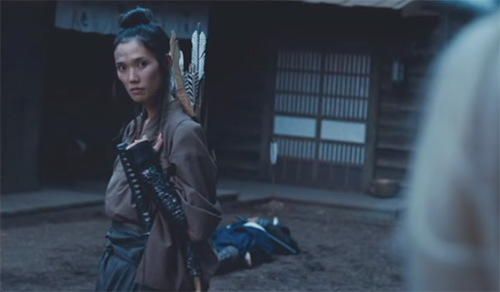
Musashi is the Japanese counterpart to West World's most wanted bandit Hector Escaton.

In this scene, in the teahouse, Hector has changed into a long summer kimono, while closely studying Musashi, unsettled at seeing himself in another host.
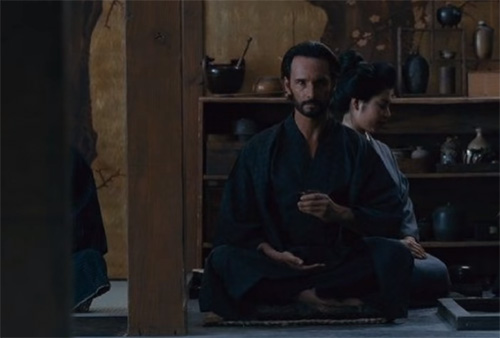
According to showrunner Jonathan Nolan, Musashi – who's a ronin – is based upon the titular character of Musashi Miyamoto on 1954 Japanese film by Hiroshi Inagaki. It was the first of three movies in the Samurai Trilogy. The story is loosely based upon the life of Musashi Miyamoto, who was a Japanese swordsman, philosopher, writer, and a ronin, who lived between the late 16th and early 17th century.
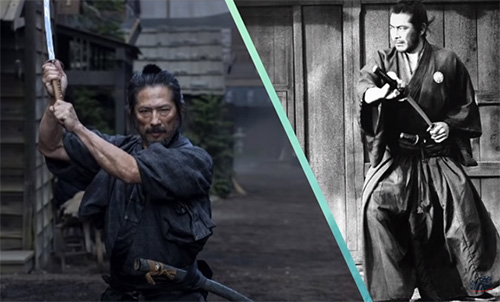
We might also compare Musashi to the ronin in the Kurosawa 1961 samurai film Yojimbo. Toshiro Mifune portrays the wandering ronin and master swordsman.

Of his influences, Nolan tells Entertainment Weekly, “… selfishly, it comes down to being obsessed with Japanese cinema as a kid and earnestly wanting to make an homage to Akira Kurosawa and the other films I grew up watching. My older brothers and I watched Sergio Leone Westerns and Kurosawa's classic samurai films and were fascinated to discover they had the same plot”.
One way that Sharen Davis connected the look of Hector to that of Musashi is by adding leather to his kimono. You see it with the pleated collar that ties in with a pleated leather plastron of Hector's jacket.

She says, “Yeah, that's the challenge of this episode, is trying to mimic each of these characters in the Japanese world. It was quite fun and very subtly done, but it's there: the leather is there, everything is there still”.
Musashi short kimono is tucked into his hakama. The word “kimono” literally means “cloth”.

The Japanese actor Hiroyuki Sanada portrays Musashi seen here in the movie “The Last Samurai”.
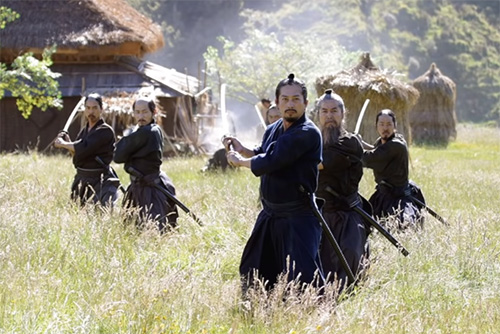
Sharen Davis, while having lived in Japan herself, leaned on many of the cast to help with dressing, saying, “It's very interesting because the cast was specifically Japanese and really knew how to do kimono and fold kimono. They were very particular how it fit. Of course, I would listen to them because they would know. They had more say in their clothes than anybody else”.
Here's an example of an antique Japanese hakama from the 2000 “Samurai: Armor of the Warrior” exhibit in Paris, France.

The back portion of the hakama pants are also made from leather and then wrapped in the front and tied into a knot.
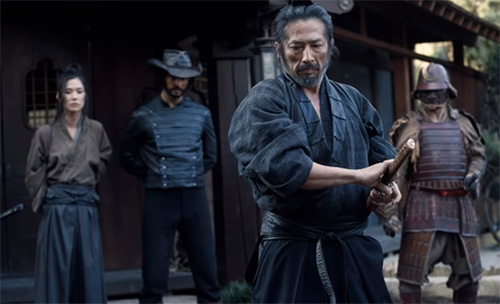
In this scene here, we see Musashi and his men also wearing conical straw hats. These hats are sometimes also called “jingasa”, although they typically don't have the point at the top.


From an auction, here's an example of a 19th-century black lacquered jingasa that's in really excellent condition, and Ichimon jingasa was primarily worn to protect from sun and rain.

The samurai class in feudal Japan used several types of jingasa – made from iron, copper, wood, paper, bamboo, or leather. Here's an example of various jingasa from the 2010 “Return of the Samurai” exhibit from the Art Gallery of Greater Victoria.

You'll also notice that Musashi is wearing a cross-harness of sorts across his back, which is meant to be a samurai equivalent of a holster. The katana is placed in the belt portion of the hakama or an obi – if he's wearing one – and then it's secured with a silk cord or leather.
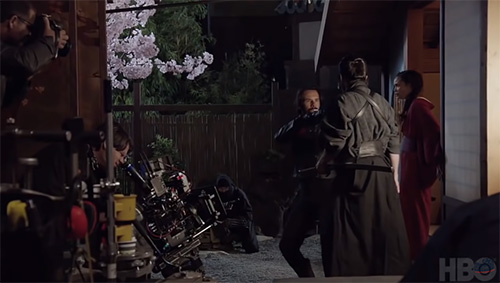
Here's the first kimono worn by Maeve in the Shogun episode. You might have noticed that her obi sash is made from the same fabric as the skirt of her salon-girl costume. Maeve is also wearing a tabi or split-toe socks.

Sharen Davis says of this, “I actually drew it off of her regular red dress – well, “regular”, her gorgeous saloon dress. I found a little floral pattern in that and then I thought, I'm going to expand this and make the kimono out of it. So I found a beautiful floral that was nowhere near Japanese or the period, and I thought, ‘I'm going to be daring and make the kimono out of this’. So it was really fun”.

Here's a close-up of the obi with fabric that's taken from Maeve's saloon costume. The fold of the kimono is tucked under the obi. This tuck is a way to shorten the kimono to ankle-length. And the obiage (or obi scarf) and the obijime (or obi cord), while both decorative, serve to keep the obi securely in place.
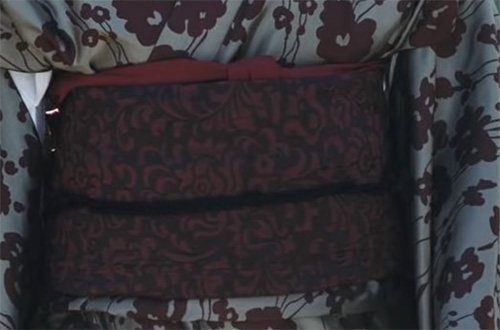
Here, they're cutting the fabric out on the reverse side.

Under the kimono, Maeve wears what's called a “nagajuban”, which is a simple white cotton kimono-shaped robe designed to separate the kimono from the body and keep the kimono clean. But you can only see the color of the undergarment.
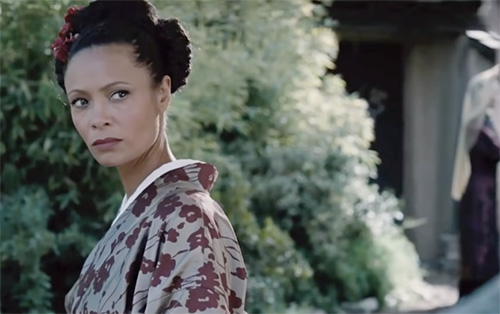
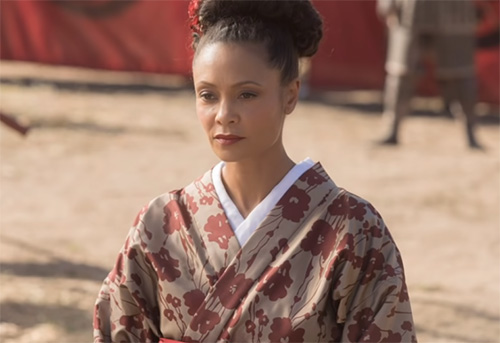
Akane is a geisha and the teahouse operator, which is the Hirafuku’s equivalent to Maeve keeping a saloon and brothel in Sweetwater.
“Akane” is the Japanese word for “deep red”. Rubio akane, otherwise known as Asian madder, is the oldest red dye used in Japan. This dye was made from the perennial plant matter (seen on the left), which grew wild in mountain regions of Japan. And on the right, are samples of akane dye swatches. But to obtain that dark red color, the process is repeated 20 or 30 times.
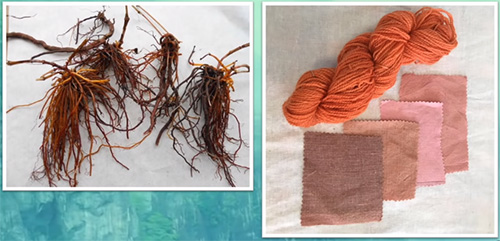
We first meet Akane wearing a resist-dyed kimono in a deep akane red color. We get a glimpse of the fancy knot of the back of the obi which is called “musubi”, which is supported by the makura or a pillow. So the makura is the Eastern equivalent of the bum pad.


Akane dresses as a Chinese emissary and presents herself with Maeve as translator to the Shogun. Her Manchurian-style costume looks slightly more contemporary – perhaps more like an early 20th-century dressing gown, rather than a garment worn by a Chinese diplomat during the Qing Dynasty, which would have run sort of in parallel to the Edo period. Shogun World isn't expected to be historically accurate though since it is a theme park and like the show itself, the team would be under similar budgets and time constraints.
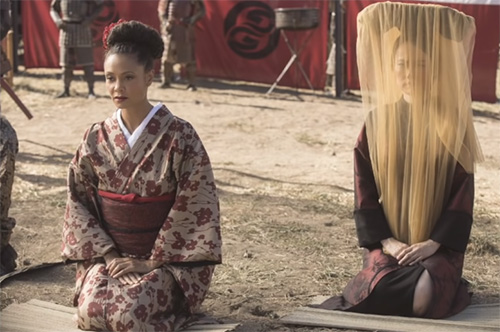
Here's the look that they maybe were trying to go for. In this picture, dating between 1875 and 1908, the dress is called a “cheongsam” or “qipao”. It's a one-piece Chinese dress that has its origins in Manchu-ruled China back in the 17th century. The style of the qipao has evolved over the decades and is still worn today.

Here's an example of a late 19th-century Qing Dynasty Chinese blue silk qipao robe. Although the Mandarin collar is missing, this robe is fastened at the shoulder with frog fasteners, like the majority of the gowns do.

Akane’s headpiece is called a “bianfang”. Although we have never seen it with a veil typically during this period, according to the Metropolitan Museum, the hair itself was arranged over a form in this geometric configuration, but during the 19th century, black satin came to be used instead.
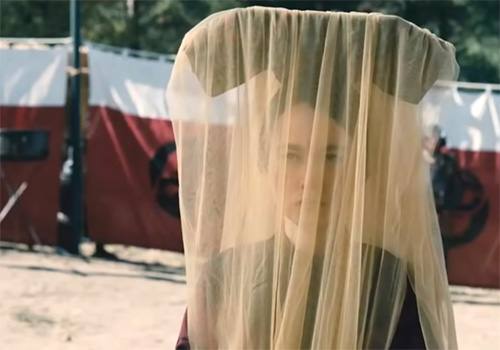
When worn, the headdress would have been elaborately decorated with tassels, jeweled ornaments, and fresh or artificial flowers.

Here's an example of a woman’s silk satin headdress from the Kangxi period of the Qing dynasty, and it's from the Metropolitan Museum of Art in New York. The headpiece is built upon a wire frame for support.

Here's Akane’s dance costume, which is an ombre-dyed furisode or long-sleeved kimono.

Akane and Sakura's costumes, dyed in their colors, are tied together with the ombre tie technique and matching golden obis.
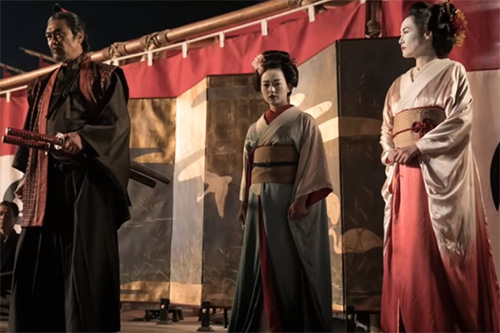
Sharen Davis stated in an interview with Insider that the kimonos created for the show were far from authentic. She said, “Kimonos take months to make, and we had weeks. There is so much structure for under them. It was really, we were like [working] 24/7 around the clock. We had so many people in town making kimonos. Like five different sewing houses making things because they are so time sensitive and they could only make them so fast”.
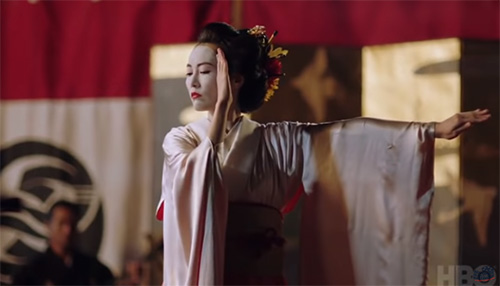
Sharen Davis said, “Basically, we didn't use large print kimonos with big flowers and stuff. We stayed very subtle and that's a little more Westworld. It's not so busy with prints and bright colors. So that works fine enough in this situation, but it's very limiting. So to make that work was really hard”.
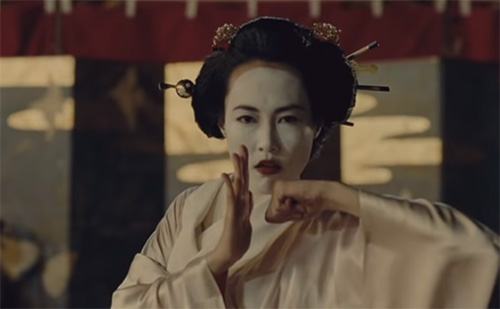
Sharen Davis adds, “We used the silhouette, but in Westworld tradition, I didn't use authentic fabric. We used our own color palette to represent West World”.
Here is the silk after it has been dyed before it was made into Akane’s kimono.

In this picture, you can see that Akane’s kimono is lined in a sort of peachy color – the body of the gown and the sleeves.

And the act of swinging long cloth or sleeves represents “tamafuri”, which means “soul swinging”. It's said to ward off evil and energize divine spirits.

It's really hard to nail down what color the kimono is. So depending on the light, it sometimes looks like a soft red, and at other times, more pink. Without seeing it on display, it's hard to know for sure.


In this shot, Akane has lost her obi, so you can see the simple underbelt of her kimono.
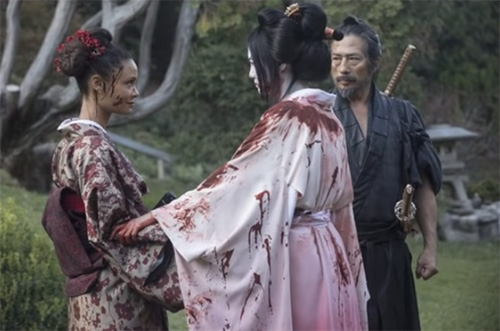
Akane’s wigs and makeup are designed to be typical of this period. Although, there are clearly some modern interpretations here.

Here's a behind-the-scenes image of one of the wigs being worked on and, according to the hair person, it was a very labor-intensive process.

It is supposed that the character of Shogun is based upon Tokugawa leyasu, founder of the Edo period Shogunate. Like the Shogun host in the Shogun World park, the real-life leyasu was respected, but also very cruel, even executing his first wife and eldest son among many other atrocities.
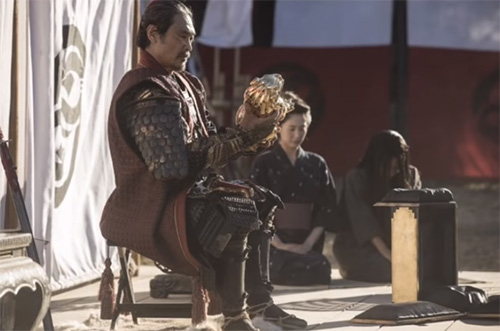
The Shogun appears to be wearing one of the earlier small-scale armors.
In this shot, the Shogun is no longer wearing armor but instead, this short kimono, hakama with a jinbaori vest on top.

This large houndstooth brocade fabric of the jinbaori is clearly contemporary. Although, the color does tie in nicely with Maeve and Akane’s costumes.

Here's an example of a Japanese samurai jinbaori.
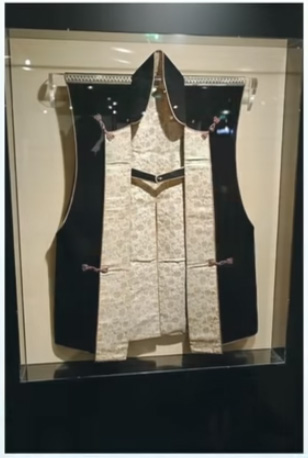
Playing a Chinese emissary for Maeve in order to fool the Shogun, Lee Sizemore dresses in a Chinese brocade tunic called a “changshan”, which is the male equivalent of the cheongsam. Changshan literally means “long shirt”. Like we stated with Akane’s Chinese costume, Lee's costume looks rather contemporary.

Here's a picture of some men wearing a variety of changshan, a style of dress widely adopted beginning under the Manchu rulers of the Qing Dynasty.
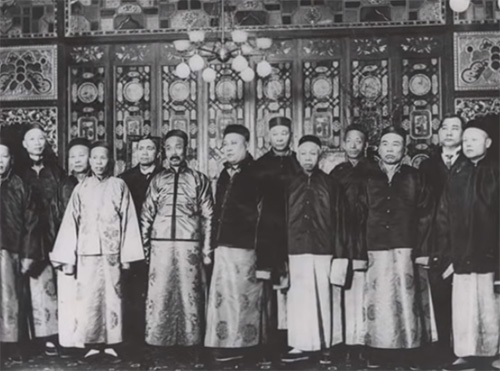
Felix and Sylvester both dress in a summer kimono called “hito-e”.
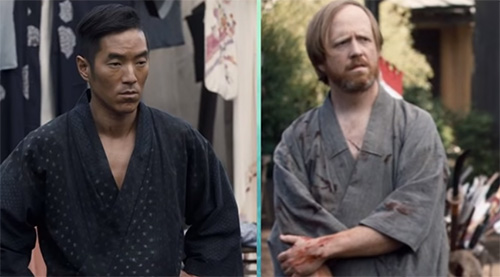
Here's a good image of one of the ninja, a covert agent or a mercenary in feudal Japan. A great number of ninjas themselves disappeared in the Edo period. Although, there were intelligence operatives who belong to the Edo Shogunate called “kogi-onmitsu”.
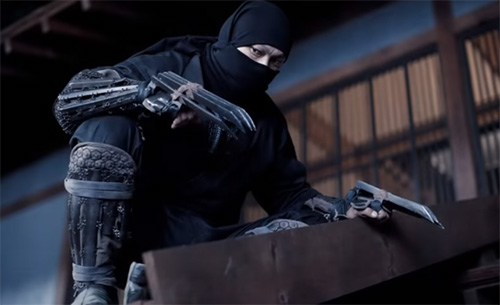
Here's an example of the claws we see on the ninja. They are called “tekko kagi”, meaning “hand claws”.
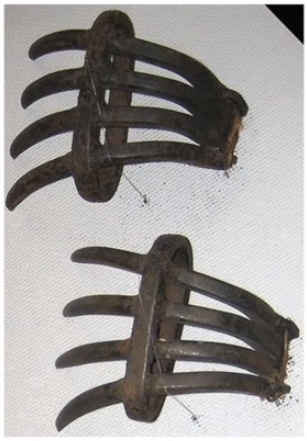
In Season 1 of West World, we were first introduced to the samurai house during a training exercise in the development session of the West World Mesa Hub. During the Edo period, the samurais were the military nobility and ruling class.

Here are some simple observations regarding the samurai costumes in the West World and Shogun World.
In the show, these samurai hosts are all dressed in modern armors made from iron plates. They are called the “new armors” because armors previously had been constructed from hundreds of individual lamellar scales. Modern armor became prominent starting in the 1500s due to the advent of firearms, new fighting tactics, and the need for additional protection.
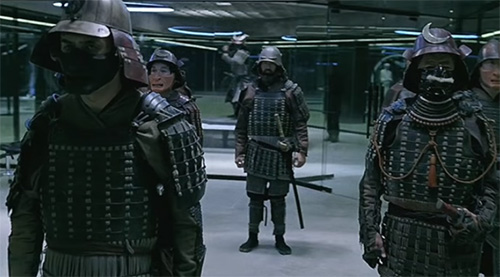
There are dozens of components that go into the samurai armor, but in many ways, it is similar to that of Western armor. You have your cuirass or breastplate (which covers the chest), the faulds (which are the short skirts that protect the legs), pauldron & vambrace to cover the shoulder and arms, and greaves that cover the shins. The samurai helm was often embellished with a crest representing family clans or animals. And a small banner bearing clan symbols called a “sashimono” was attached to the back of the cuirass by special fittings.
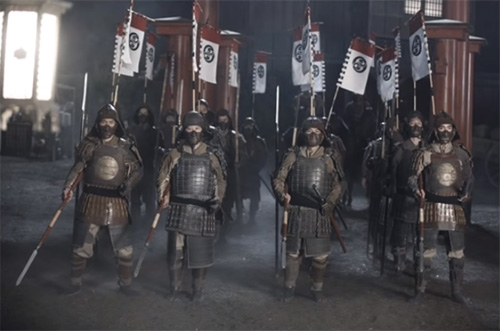
Here's an example of the Edo period Japanese armor called “okegawa ni-mai”, which refers to the tub-like shaped cuirass, which hinges together under the left arm. This complete set of armor is from the “Return of the Samurai”, 2010 exhibit in Victoria B.C. Canada.
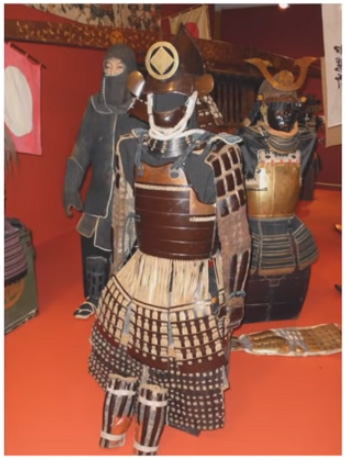
One of the samurai hosts wears a mengu, meaning “faceplate”.

Here's an example of a Japanese samurai faceplate or mask from the early 17th century from “Samurai: Armor of the Warrior” 2011 exhibit in Paris, France.

One of the most important aspects of the samurai armor is the helm called “kabuto”. A typical kabuto features a central dome constructed of anywhere from 3 to over a 100 metal plates riveted together. But this Zunari kabuto, like the one we see predominantly in Shogun World, is a simple five-plate design.

(c)


